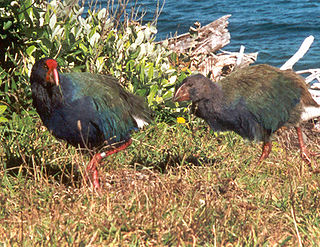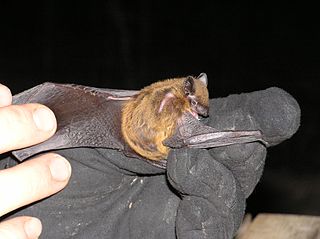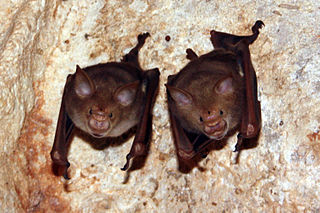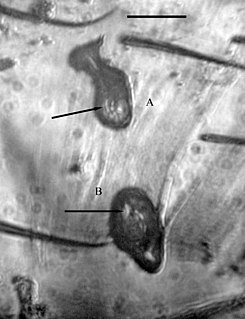
The New World leaf-nosed bats (Phyllostomidae) are found from southern North America to South America, specifically from the Southwest United States to northern Argentina. They are ecologically the most varied and diverse family within the order Chiroptera. Most species are insectivorous, but the phyllostomid bats include within their number true predatory species and frugivores. For example, the spectral bat, the largest bat in the Americas, eats vertebrate prey, including small, dove-sized birds. Members of this family have evolved to use food groups such as fruit, nectar, pollen, insects, frogs, other bats, and small vertebrates, and in the case of the vampire bats, even blood.

Desmodus is a genus of bats which—along with the genera Diaemus and Diphylla—are allied as the subfamily Desmodontinae, the carnivorous, blood-consuming vampire bats of the New World leaf-nosed bat family Phyllostomidae.

In paleontology, a Lazarus taxon is a taxon that disappears for one or more periods from the fossil record, only to appear again later. Likewise in conservation biology and ecology, it can refer to species or populations that were thought to be extinct, and are rediscovered. The term Lazarus taxon was coined by Karl W. Flessa & David Jablonski in 1983 and was then expanded by Jablonski in 1986. Wignall and Benton defined Lazarus taxa as, "At times of biotic crisis many taxa go extinct, but others only temporarily disappeared from the fossil record, often for intervals measured in millions of years, before reappearing unchanged". Earlier work also supports the concept though without using the name Lazarus taxon, like work by Christopher R. C. Paul.

Nycticeius is a small genus of bats in the vesper bat family, Vespertilionidae, and the only member of the tribe Nycticeiini. It contains three species, the evening bat, the Cuban evening bat and Nycticeius aenobarbus. Some authorities include several other Old World species in Nycticeius, but recent genetic work shows that is a completely New World genus. Nycticeius is of Greek and Latin origin, meaning "belonging to the night".

The little goblin bat is a species of bat in the family Molossidae, the free-tailed bats. It is endemic to Cuba.

The genus Cathartes includes medium-sized to large carrion-feeding birds in the New World vulture (Cathartidae) family. The three extant species currently classified in this genus occur widely in the Americas. There is one extinct species known from the Quaternary of Cuba.

Leach's single leaf bat, also known as Greater Antillean long-tongued bat, is a species of bat in the family Phyllostomidae. It is found in the southern Bahamas and in all the Greater Antilles. It forms large colonies, with up to a few hundred thousand individuals, and feeds on a relatively wide variety of food items including pollen, nectar, fruit and insects.

The Cuban fig-eating bat, or white-shouldered bat, is a species of bat in the family Phyllostomidae, found only in the Caribbean. It is the sole extant species in the genus Phyllops, although two other species, P. vetus and P. silvai, are known from fossils.
The sooty mustached bat is a species of bat in the family Mormoopidae. It is found in Cuba, the Dominican Republic, Haiti, Jamaica, and Puerto Rico.

The Hipposideridae are a family of bats commonly known as the Old World leaf-nosed bats. While it has often been seen as a subfamily, Hipposiderinae, of the family Rhinolophidae, it is now more generally classified as its own family. Nevertheless, it is most closely related to Rhinolophidae within the suborder Yinpterochiroptera.

Antrozoini is a tribe of bats in the subfamily Vespertilioninae of the family Vespertilionidae. It contains the pallid bat, Van Gelder's bat, the genus Rhogeessa, and the fossil Anzanycteris.

Vetufebrus is an extinct genus of haemospororida in the family Plasmodiidae. At the time of its description the new genus comprised a single species Vetufebrus ovatus known from a single Miocene Dominican amber fossil found on Hispaniola. V. ovatus was vectored by Enischnomyia stegosoma, the first fossil steblid bat fly described from a fossil, and the only member of the subfamily Nycterophiliinae described from Hispaniola. V. ovatus is the first instance of a Streblidae bat fly as a host for a malarial parasite.
Gymnogyps varonai, sometimes called the Cuban condor, is an extinct species of large New World vulture in the family Cathartidae. G. varonai is related to the living California condor, G. californianus and the extinct G. kofordi, either one of which it may have evolved from. The species is solely known from fossils found in the late Pleistocene to early Holocene tar seep deposits in Cuba. G. varonai may have preyed upon carcasses from large mammals such as ground sloths.

The Florida bonneted bat or Florida mastiff bat is a species of bat in the genus Eumops, the bonneted bats or mastiff bats. Until recently, it was classified as a subspecies of Wagner's bonneted bat . It is endemic to southern Florida in the United States. This species has one of the smallest geographical distributions of any New World bat. It has been called "one of the most critically endangered mammal species in North America". It is protected under the Endangered Species Act.

The Cuban greater funnel-eared bat is a species of funnel-eared bat. It is endemic to a cave in westernmost Cuba. it is a member of the family Natalidae.

Enischnomyia is an extinct genus of bat fly in the family Streblidae. At the time of its description the new genus comprised a single species, Enischnomyia stegosoma, known from a single Miocene fossil found on Hispaniola. E. stegosoma was the first fossil steblid bat fly described from a fossil, and the only member of the subfamily Nycterophiliinae described from Hispaniola. The species is host for the plasmodiid Vetufebrus ovatus preserved in its salivary glands and midgut.
Submyotodon is a genus of vespertilionid bats, published as a new taxon in 2003 to describe a Miocene fossil species. Extant species and subspecies previously included in Myotis were later transferred to this genus. Species in this genus are referred to as broad-muzzled bats or broad-muzzled myotises.
Dasypterus is a genus of or subgenus of vesper bat. As a genus, it includes species that were formerly in the genus Lasiurus. Collectively, members of Dasypterus are referred to as the yellow bats.













